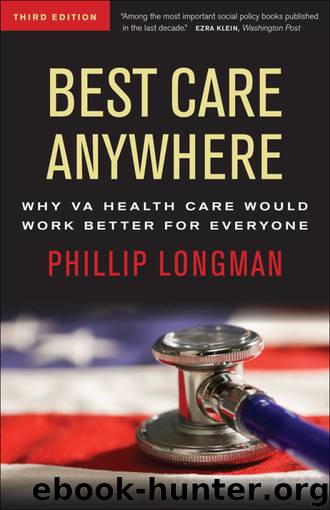Best Care Anywhere by Phillip Longman

Author:Phillip Longman [Longman, Phillip]
Language: eng
Format: epub
ISBN: 9781609945176
Publisher: Berrett-Koehler Publishers
Published: 2012-03-15T04:00:00+00:00
Quality Doesn’t Pay
If this strikes you as too harsh, take a breath and consider. With the exception of the VA, what do most health-care providers get paid to do? Provide health? Hardly. They get paid to provide treatments, and there’s a big difference. This is not to suggest that most doctors are simply profit maximizers or indifferent to your health. Many in all walks of medicine are profoundly idealistic and believe in providing the highest-quality medicine possible. But given the system under which they operate, there is only so much idealism they can afford.
That’s because, according to Lawrence P. Casalino, professor of public health at Weill Cornell Medical College, “The U.S. medical market as presently constituted simply does not provide a strong business case for quality.”2
Casalino speaks from his own past experience as a solo practitioner and on the basis of over 800 interviews he has since conducted with health-care leaders and corporate health-care purchasers. While practicing medicine in Half Moon Bay, California, Casalino had an idealistic commitment to following emerging best practices in medicine. That meant spending lots of time educating patients about their diseases, arranging for careful monitoring and follow-up care, and trying to keep track of which prescriptions and procedures various specialists might be ordering.
Yet Casalino quickly found out that his commitment to quality wasn’t sustainable, given the rules under which he was operating. Nobody paid him for the extra time he was spending with his patients. He might have eased his burden by hiring a nurse to assist with all the routine patient education and follow-up care that was keeping him at the office too late. Or he might have teamed up with other providers in the area and invested in computer technology that would have allowed them to offer the same coordination of care found in veterans hospitals and clinics today. Both steps would have improved patient safety and added to the quality of care he was providing. But even had he managed to pull them off, he stood virtually no chance of seeing any financial return on such investments. As a private-practice physician, he got paid for treating patients, not for keeping them well or helping them to recover faster.
The same problem exists across all health-care markets, and it’s a major factor in explaining why the VA has a quality performance record that exceeds that of private-sector providers. For example, suppose a privately managed care plan follows the VA example and invests in a computer program to identify diabetics and keep track of whether they are getting appropriate follow-up care. The costs are all up front, but the benefits may require twenty years to materialize. And by then, unlike in the VHA system, the patient will likely have moved on to some new health-care plan. As the chief financial officer of one health-care provider told Casalino: “Why should I spend our money to save money for our competitors?”
Or suppose an HMO takes a more idealistic attitude and decides to invest in improving the quality of its diabetic care anyway.
Download
This site does not store any files on its server. We only index and link to content provided by other sites. Please contact the content providers to delete copyright contents if any and email us, we'll remove relevant links or contents immediately.
The Secret History by Donna Tartt(18840)
The Social Justice Warrior Handbook by Lisa De Pasquale(12141)
Thirteen Reasons Why by Jay Asher(8791)
This Is How You Lose Her by Junot Diaz(6778)
Weapons of Math Destruction by Cathy O'Neil(6139)
Zero to One by Peter Thiel(5684)
Beartown by Fredrik Backman(5594)
The Myth of the Strong Leader by Archie Brown(5421)
The Fire Next Time by James Baldwin(5247)
How Democracies Die by Steven Levitsky & Daniel Ziblatt(5127)
Promise Me, Dad by Joe Biden(5087)
Stone's Rules by Roger Stone(5026)
100 Deadly Skills by Clint Emerson(4840)
A Higher Loyalty: Truth, Lies, and Leadership by James Comey(4840)
Rise and Kill First by Ronen Bergman(4701)
Secrecy World by Jake Bernstein(4640)
The David Icke Guide to the Global Conspiracy (and how to end it) by David Icke(4624)
The Farm by Tom Rob Smith(4434)
The Doomsday Machine by Daniel Ellsberg(4415)
